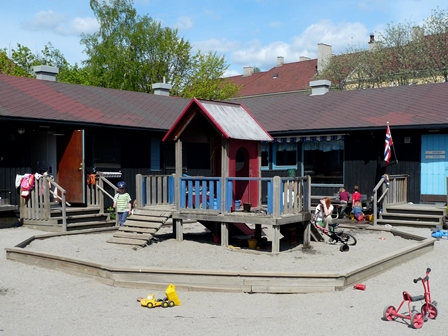Available outdoor space and competing needs in public kindergartens in Oslo
DOI:
https://doi.org/10.7577/formakademisk.601Keywords:
children’s right to play, outdoor play area, parking, space discourseAbstract
To be able to plan a diverse and flexible environment in kindergartens, available and adequate space is needed, preferably an open and coherent space adaptable to change. Hence, size itself is a factor to control and regulate to ensure that children’s needs are met. The aim of this study was to investigate how the utilization of outdoor space responded to changes in applied norms and law over time. The hypothesis was that needs for space of a more administrative nature, such as parking, have been prioritized over play area. To test this hypothesis, 201 public kindergartens in Oslo’s outer city that offer full-day service were studied. The main findings were that the gross size of kindergartens in Oslo decreased by 12.6 m2 per child for those built after 2006 compared to those built before 1975, due to legal changes in these time intervals, and that play space per child constituted more than half of this decrease. In the same time period, the reduction in space for parking and roads on the premises decreased by only 1.6%. This finding suggests that norms founded in laws win the battle over space, even if this indirectly compromises the meeting of children’s needs for an adequate outdoor play area.
Downloads
Published
2014-08-15
How to Cite
Nilsen, A. H. (2014). Available outdoor space and competing needs in public kindergartens in Oslo. FormAkademisk, 7(2). https://doi.org/10.7577/formakademisk.601
Issue
Section
Articles
License
Authors who publish with this journal agree to the following terms:
- Authors retain copyright and grant the journal right of first publication with the work simultaneously licensed under a Creative Commons Attribution 4.0 License that allows others to share the work with an acknowledgement of the work's authorship and initial publication in this journal.
- Authors are able to enter into separate, additional contractual arrangements for the non-exclusive distribution of the journal's published version of the work (e.g., post it to an institutional repository or publish it in a book), with an acknowledgement of its initial publication in this journal.
- Authors are permitted and encouraged to post their work online (e.g., in institutional repositories or on their website) prior to and during the submission process, as it can lead to productive exchanges, as well as earlier and greater citation of published work (See The Effect of Open Access).
- The author(s) must manage their economic reproduction rights to any third party.
- The journal makes no financial or other compensation for submissions, unless a separate agreement regarding this matter has been made with the author(s).
- The journal is obliged to archive the manuscript (including metadata) in its originally published digital form for at least a suitable amount of time in which the manuscript can be accessed via a long-term archive for digital material, such as in the Norwegian universities’ institutional archives within the framework of the NORA partnership.
The material will be published OpenAccess with a Creative Commons 4.0 License which allows anyone to read, share and adapt the content, even commercially under the licence terms:
This work needs to be appropriately attributed/credited, a link must be provided to the CC-BY 4.0 licence, and changes made need to be indicated in a reasonable manner, but not in any way that suggests that the licensor endorses you or your use.



